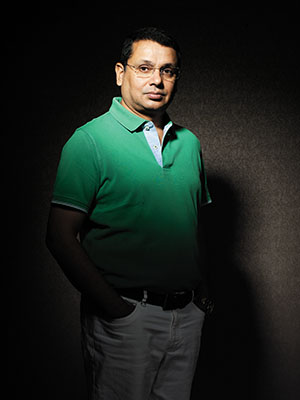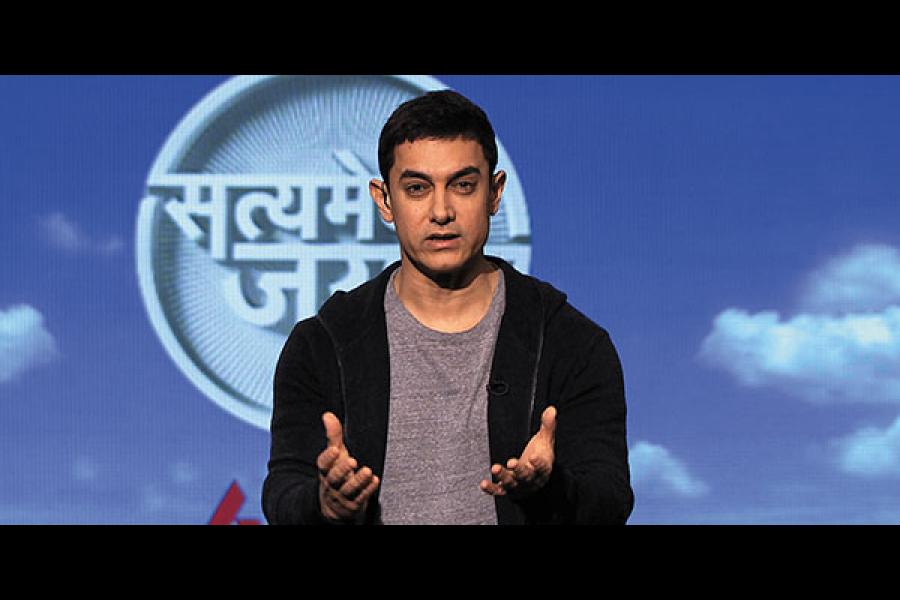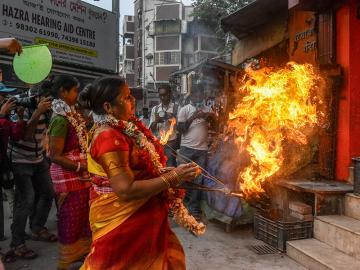
We Have To Challenge The Status Quo: Star India CEO Uday Shankar
Star India CEO Uday Shankar on why taking risks is critical for shaping content strategy and digital growth
When journalist Uday Shankar took over 21st Century Fox-owned Star India in 2007, its leadership was under pressure. A thoughtful risk taker, Shankar took unconventional decisions to give content a new lease of life. He attempted to make Indian television more socially relevant: Serials like Kyunki Saas Bhi Kabhi Bahu Thi and Kahani Ghar Ghar Ki made way for powerful, women-led serials like Diya Aur Baati Hum, Saathiya and Pratigya that hit the bull’s eye with audiences and advertisers.
Shankar then turned conventional entertainment programming on its head by roping in Aamir Khan to do Satyamev Jayate. The talk show bulldozed its way into India’s social consciousness by taking a deep dive into hard-hitting issues like rape, dowry, and sex-selective abortions. The third season is now in the works.
Satyamev Jayate caught the eye of boss James Murdoch, the co-chief operating officer, at 21st Century Fox. Shankar says Murdoch threw a lifeline to Satyamev Jayate at a time when others in the company were seeing it as an extravagant exercise in lunacy. According to reliable sources, Satyamev Jayate costs a staggering Rs 5 crore an episode so it was a bold risk.
“I was told by a company executive that I was “totally out of line,” when I discussed the concept of Satyamev Jayate. So I spoke with James and asked if I had his approval to go ahead and risk this whole investment,” says Shankar. “He said ‘we would live’.”
So successful is the show now that it costs more than twice as much for a slot in the ad breaks as it does for cricket’s IPL. The first season, consisting of 13 episodes, was viewed by 517 million Indians.
Shankar is now placing another studied bet: Star is spending Rs 20,000 crore on sports to cultivate male viewers. He is betting on India, with the world’s youngest population, to spur demand for sports. Analysts say it’s a paying market with ad spend on sports packages pegged at roughly Rs 4,000 crore annually.
Star beams over 5,000 hours of live sports through six sports channels, but Shankar plans to take sports broadcasting to local tournaments. He is also building a digital growth avenue through starsports.com to deliver sports online. Star is biting the bullet and forking over Rs 3,851 crore to BCCI for television rights until 2018.
Television audience measurements show Star has sharp-cornered 24.8 percent market share, taking the lead on rivals Zee TV and Sony who have 16 percent and 10 percent respectively. Star’s revenue has expanded 25 percent in the last five years to over Rs 6,400 crore. Murdoch recently touted the growth outlook for the Indian business, saying it could eventually top operating profit of $1 billion a year.
Shankar talked to Forbes India about Star's digital dreams, the importance of putting the spotlight on social issues in India and the path forward.
Q. Why did you divest your stake in home shopping venture Star CJ Network?
My team and I were not very excited about home shopping since the core proposition of Star network is unique proprietary content.
Q. Have a lot of global media companies made the mistake in India of bringing a business model and trying to work with it willy-nilly? How has Star done things differently?
A lot of people and media companies have tried to foist a foreign business model on India. That simply doesn’t work. India has too much social, economic and language diversity. We also have our own sensibility.
What has Star done in India? Our parentage and ownership is global but Star has become an Indian company. If you ask ordinary viewers, they don’t know that Star has foreign ownership. This is because our programming reflects sensibilities that are uniquely Indian and capture both the legacy and aspiration of India. That’s been the core of the Indianisation.
I would like to think my own background helped somewhat in that as an Indian journalist you are aware of issues that people care about. The first requirement of credibility is familiarity. You have to become an insider when you try to build a media business in India and earn trust — that is what we have done.
We have expanded Star’s operations in India into 34 channels in seven languages and regional brands that reach about 650 million viewers every week.
Q. Keeping in mind the regulatory environment, how do you think the pending unbundling of distribution will affect the alliances in the market? How is the enforcement on the advertising limits affecting your business?
The unbundling will affect everybody. Indian channels were distributed by bringing together a lot of third party channels to create a bouquet for customers. The regulator has said you can do that but contracts will have to be separate so it has effectively been unbundled. For the first time, the power of content has come into play aggressively. If you have channels that are leader channels people want to watch, you will be able to distribute them without any problem. In each market the power of content is finally coming into play, far more aggressively, than in the past.
On the advertising front, things had got undisciplined. There were channels running 30 minutes to an hour of advertising. No professional broadcaster was doing that — even when there was no limit, Star was disciplined. But this was building consumer annoyance. And the beneficiary of this was not the channels. The channels were not making money; they were just keeping the advertising rate low. It was the advertisers and the advertising agencies that were able to buy cheap, because inventories could bloom. Now, there is rationalisation in the rates and deliveries of the channels. In the long run, limiting the advertising inventory is a good development for consumer and content creators.
Q. How do you find the budget for shows like Satyamev Jayate? What role does Fox play in allowing you to spend money?
James (Murdoch) is extremely supportive of what we are trying to do. We realised that to differentiate ourselves and live up to the full potential of media content, we have to challenge the status quo. Fox is clear, Star is a brand with purpose that we are building for the future and unless we integrate the concerns Indians have today, it will be difficult to deliver on people’s expectations and build the business that we are building.
We know that some shows may not measure up on the profit scale. Yet, those shows must be done because they are good for Star; they are good for India and Star’s relationship with India. The method is simple: Invest in good content, invest in marketing and building a brand and use that to build leadership and then get a premium for that leadership. So, whether it is in advertising or affiliate income, Star gets a better premium than any other broadcaster.
With Satyamev Jayate the idea was not to do a show with the highest-ever ratings. Aamir and I spent time discussing the show and decided we were not going to pull our punches in the creative expression and format. We wanted to force a discussion, to bring serious issues, the darkest secrets of our society into the spotlight. The show has done well, but it’s not an easy show to do. It’s an expensive show because it requires painstaking research and work. But above all, the show is a bigger viewer success than we ever imagined and the response from the advertisers has been excellent.
Q. Given the unprecedented success of Satyamev Jayate, are you coming back with the third season?
We are working with Aamir and hopefully in the next few months we will come back with the next season. We are very keen to come back with a short season in 2014, but it would depend on our research being ready and finding time in Aamir’s calendar.
Q. Was it a conscious decision to introduce new serials featuring stronger female protagonists and higher-quality production?
Creatively we have targeted women to be at the core of our shows. We never portray women in regressive ways. The driver characters for change are women, primarily because we have felt that they are the biggest ambassadors of change and proselytisers in their own context. If a woman gets convinced, then the first impact is felt by the children and then subsequently the male members. Indian women want change for themselves, their families and their country, and Star is reflecting that change.
Q. You have expanded Star’s channels into seven languages and regional brands. What is next?
We are trying to build a sports franchise that goes beyond India’s love affair with cricket played in international venues and the Indian Premier League. There is an underlying demand for multiple sports and it is waiting to be tapped. That’s why we are very heavily involved in promoting local leagues, probably better than any broadcaster has done anywhere.
We have partnered with Reliance Industries and IMG to create an Indian Super League for football. We are partnering with the hockey federation for a league and we are working to create a national kabaddi league. We are powering digital delivery of content via the internet for all kinds of sports.
But the main thing is that we are going beyond just telecasting sports and actually promoting the culture of diverse sports in India. We are hoping to work with the sports authorities to make local sports popular. Unless you build a large portfolio of sports and create a stream of events and excitement in each of these sports, you can’t create a viewership base. There is no reason for India to be a one-sport country. We have so many young people waiting to be involved actively with different sports.
We are also focussed on unlocking the power of digital through our website starsports.com. We started it less than a year ago to deliver very high quality content for sports. That has had a good take off. The video streaming of Pepsi IPL 2014 created a record in May, for the highest traffic for a sporting event outside the Super Bowl in the US. On the back of two big playoff matches, Chennai Super Kings vs Mumbai Indians, and Kings XI Punjab vs Kolkata Knight Riders, starsports.com attracted 2.8 million unique viewers. We have succeeded in creating a new destination for sports, and that is the mobile screen.
You have said that “with the right to question, must come the right to provoke and the right to offend”. Would you say that free speech has innumerable enemies in India and few principled defenders? The state either stands by and does nothing to protect free speech or actively abets its suppression.
Yes, in subtle and not so subtle ways. To give you an example, in the last two years, the previous government did not give licenses for television channels. They introduced all kinds of delaying tactics. They insisted on fresh security approval for the companies that were already in the business of broadcasting.
I do believe the right to information, right to democracy, right to free speech; none of these are upheld in spirit and substance unless the right to offend is acknowledged. I totally understand that sentiments can get hurt, but you can’t say that no matter what I say you will get offended. Hence, I shouldn’t say anything! That is bizarre and that’s what the instruments of state and policy establishment have been using to clamp down on media —regardless of which political dispensation you are talking about. There’s an unstated political consensus on keeping the Indian media unevolved and emaciated.
Q. Has Satyamev Jayate been picked up by foreign countries?
When Star aired the first season of Satyamev Jayate it got inquiries from many parts of Asia and Africa, but China showed the strongest interest. We have just sold the rights of the show to a production company in China.
Q. Does this mean that more films and television shows that come out of India will be embraced by the foreign market?
The Indian market is so big that both Bollywood and the Indian television industry are quite satisfied, especially in the early stages of development. You get good growth, you make good money, and you get national recognition. I think Indians have not yet shown that ambition. Still, it’s a romantic aspiration that someday we will make a global film or a global television show… it will happen. The big problem I see is cracking the distribution pipe — it’s not very easy.
Hollywood has built this amazing distribution ecosystem all over the world and it’s not easy to break into that. I think it’s all about the trade channel and finding the way of creating a global brand. A Hollywood film sells because the director is known world over, the actor is known and then there is this great marketing and distribution infrastructure. Indians haven’t been able to do that. If I mention a top Indian director in New York, I don’t think there will be many people who would know him. It will take time.
But our entertainment content has great appeal in South Asia and our digital expansion takes this into cognisance. The appeal is not just limited to the Indian diaspora but the South Asian diaspora. New technology and the internet now allow content to be streamed to every South Asian home in the world. That is our mission.
(This story appears in the 25 July, 2014 issue of Forbes India. To visit our Archives, click here.)
-
 Meenakshi .s.rao
Meenakshi .s.raoThis reply is a comment regarding your show Satya Meva Jayate ....one of the best shows I have ever seen on TV and really appreciated the work done by Aamir Khan whom we adore a lot and has already kept a place in our hearts. In fact When this show was going on I had shared each episode with my friends and relatives promoting this show .You don\'t know how much we educated people do encouraging such shows on Star Plus even though we have our family burdens . We sometimes need time for ourselves but still running my own N.G.O ...Saksharatha Mission....Educating women in English Communicative skills, tailoring , quilting and some personality developement classes to make them strong in life . I insist them they should learn to live for themselves and fulfill their dreams ...become independent in life without stretching their hands for support . Recently I supported a TV serial on Starplus ...Manmarzia ...went to the extent of falling on the Creative team through the support of all fans from India and abroad ...filing a online petition with the help of my friends ,Hash ,Latha Swamy and the rest . As a senior I feel there is no place for us to put forward our demands regarding the show .The Starplus is depriving us of our basic priorities of life . Uday Shankarji , when fame and name comes to you , YOU people forget the support given so far . I think money plays an important part in ones life . No value for emotional trauma these youngsters are going through by snatching away Manmarzia from them .Where is Aamir Khan\'s ...\" MUMKIN HAI \' ...For me at the fag end of my line ,as I am already 66 yrs , everything is impossible the opposite of mumkin hai ....Regards, Meenakshi.S.Rao
on Aug 23, 2015
















